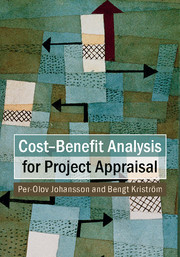Book contents
- Frontmatter
- Dedication
- Contents
- List of illustrations
- List of tables
- Preface
- 1 Introduction
- 2 The basic cost–benefit (C–B) model
- 3 Market distortions
- 4 Intertemporal generalization
- 5 Natural resources
- 6 Small versus large projects
- 7 Aggregation
- 8 Appraisal in a risky world
- 9 Notes on estimation techniques
- 10 A smörgåsbord of further topics
- 11 Robustness checks and due diligence in evaluations
- References
- Index
1 - Introduction
Published online by Cambridge University Press: 05 November 2015
- Frontmatter
- Dedication
- Contents
- List of illustrations
- List of tables
- Preface
- 1 Introduction
- 2 The basic cost–benefit (C–B) model
- 3 Market distortions
- 4 Intertemporal generalization
- 5 Natural resources
- 6 Small versus large projects
- 7 Aggregation
- 8 Appraisal in a risky world
- 9 Notes on estimation techniques
- 10 A smörgåsbord of further topics
- 11 Robustness checks and due diligence in evaluations
- References
- Index
Summary
Cost–benefit analysis (CBA) offers a formal approach for decision makers to delineate the costs and benefits of different policies. Although the conceptual underpinnings of CBA may be traced to the nineteenth-century French civil engineer and economist Jules Dupuit, see Dupuit (1844), extensive application had to wait until the twentieth century. Propelled by a rising demand for electricity and substantial damage from several serious floods, the US Congress passed two significant flood control acts (referred to here as the 1936 Act and the 1944 Act, respectively). The 1936 Act called for “works of improvement” on more than fifty major rivers throughout the United States and made flood control a federal government activity. Importantly, the Act introduced an approach to prioritizing projects:
The Federal Government should improve or participate in the improvement of navigable waters or their tributaries, including watersheds … for flood control if the benefits to whomsoever they may accrue are in excess of estimated costs.
In 1981 President Reagan issued Executive Order 12291 that stated that “regulatory action shall not be undertaken unless the potential benefits to society for the regulation outweigh the potential costs to society.” This is the essence of cost– benefit analysis: a project is recommended if the benefits (whomever they accrue to) exceed the costs. A critical issue is how to measure costs and benefits and what is meant by benefits exceeding costs. Pareto (1896–1897) argued that a project should be undertaken only if at least one individual is made better off while no one is made worse off. This is a nice criterion but it is seldom fulfilled by actual projects since they tend to generate both winners and losers. The Kaldor– Hicks “compensation principle” (Hicks 1939, Kaldor 1939) established the idea of hypothetical compensation as a practical rule for deciding on policies and projects. When winners, at least hypothetically, are able to compensate losers there is a hypothetical or potential Pareto improvement. This might seem to be an elegant way of circumventing the problem of aggregating individual and unobservable utility changes due to a policy. Nonetheless it draws on a strong ethical assumption, namely, that the pure possibility of compensation is enough to motivate a project.
- Type
- Chapter
- Information
- Cost-Benefit Analysis for Project Appraisal , pp. 1 - 8Publisher: Cambridge University PressPrint publication year: 2015



